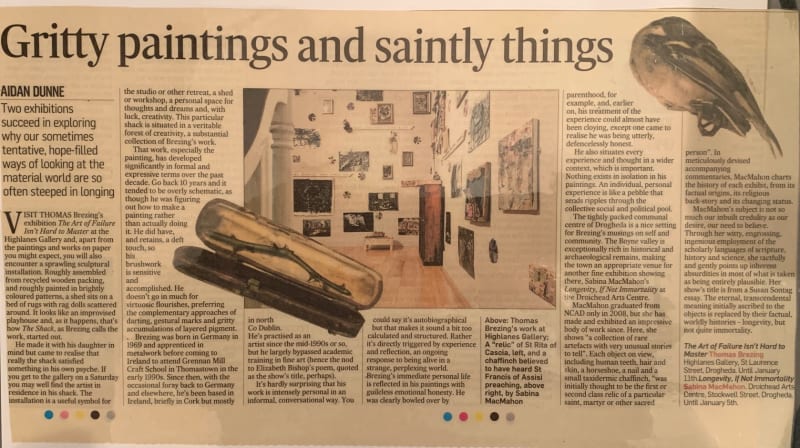VISIT THOMAS Brezing’s exhibition The Art of Failure Isn’t Hard to Masterat the Highlanes Gallery and, apart from the paintings and works on paper you might expect, you will also encounter a sprawling sculptural installation. Roughly assembled from recycled wooden packing, and roughly painted in brightly coloured patterns, a shed sits on a bed of rugs with rag dolls scattered around. It looks like an improvised playhouse and, as it happens, that’s how The Shack, as Brezing calls the work, started out.
He made it with his daughter in mind but came to realise that really the shack satisfied something in his own psyche. If you get to the gallery on a Saturday you may well find the artist in residence in his shack. The installation is a useful symbol for the studio or other retreat, a shed or workshop, a personal space for thoughts and dreams and, with luck, creativity. This particular shack is situated in a veritable forest of creativity, a substantial collection of Brezing’s work.
That work, especially the painting, has developed significantly in formal and expressive terms over the past decade. Go back 10 years and it tended to be overly schematic, as though he was figuring out how to make a painting rather than actually doing it. He did have, and retains, a deft touch, so his brushwork is sensitive and accomplished. He doesn’t go in much for virtuosic flourishes, preferring the complementary approaches of darting, gestural marks and gritty accumulations of layered pigment.
Brezing was born in Germany in 1969 and apprenticed in metalwork before coming to Ireland to attend Grennan Mill Craft School in Thomastown in the early 1990s. Since then, with the occasional foray back to Germany and elsewhere, he’s been based in Ireland, briefly in Cork but mostly in north Co Dublin. He’s practised as an artist since the mid-1990s or so, but he largely bypassed academic training in fine art (hence the nod to Elizabeth Bishop’s poem, quoted as the show’s title, perhaps).
It’s hardly surprising that his work is intensely personal in an informal, conversational way. You could say it’s autobiographical but that makes it sound a bit too calculated and structured. Rather it’s directly triggered by experience and reflection, an ongoing response to being alive in a strange, perplexing world. Brezing’s immediate personal life is reflected in his paintings with guileless emotional honesty. He was clearly bowled over by parenthood, for example, and, earlier on, his treatment of the experience could almost have been cloying, except one came to realise he was being utterly, defencelessly honest.
He also situates every experience and thought in a wider context, which is important. Nothing exists in isolation in his paintings. An individual, personal experience is like a pebble that sends ripples through the collective social and political pool.
The tightly packed communal centre of Drogheda is a nice setting for Brezing’s musings on self and community. The Boyne valley is exceptionally rich in historical and archaeological remains, making the town an appropriate venue for another fine exhibition showing there, Sabina MacMahon’s Longevity, If Not Immortalityat the Droichead Arts Centre.
